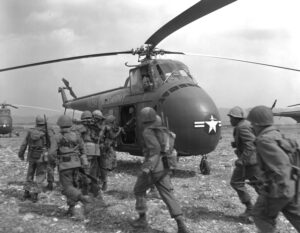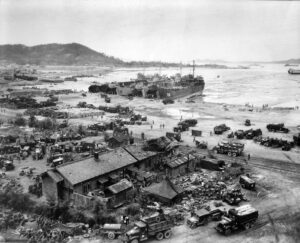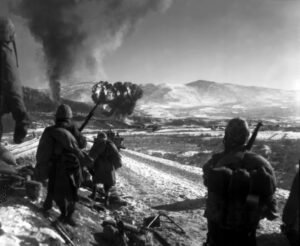 Most wars are nation against nation or against nations, but some wars split a nation in two…literally. Such was the case in Korea, which was once one nation, and after the war, became two nations. It seems like no matter which nation invades the other, or the other half, the invading nation is always trying to enslave the other nation or the other half of the nation. In the case of Korea, South Korea wanted to be a Democratic nation, and North Korea wanted to be a Communist nation. They have been fighting about their differences for years. That is simply a fight, South Korea couldn’t afford to lose, and really, North Korean people didn’t want communism either. Anyone who studies socialism and communism is clearly able to see that neither of these forms of government benefit the people of the nation. They just benefit the government. The nation split into two nations, and it was a battle to hold off North Korea from that day forward.
Most wars are nation against nation or against nations, but some wars split a nation in two…literally. Such was the case in Korea, which was once one nation, and after the war, became two nations. It seems like no matter which nation invades the other, or the other half, the invading nation is always trying to enslave the other nation or the other half of the nation. In the case of Korea, South Korea wanted to be a Democratic nation, and North Korea wanted to be a Communist nation. They have been fighting about their differences for years. That is simply a fight, South Korea couldn’t afford to lose, and really, North Korean people didn’t want communism either. Anyone who studies socialism and communism is clearly able to see that neither of these forms of government benefit the people of the nation. They just benefit the government. The nation split into two nations, and it was a battle to hold off North Korea from that day forward.
On June 27, 1950, President Harry S Truman announced that he is ordering United States Air and Naval forces to South Korea to aid the democratic nation in fighting off an invasion by communist North Korea. The Korean War had begun, and it would rage on until July 27, 1953. Truman explained that the United States was undertaking the major military operation to enforce a United Nations resolution calling for an end to hostilities, and to stem the spread of communism in Asia. Truman also sent the United States 7th Fleet to Formosa (Taiwan) to fend of any possible invasion by communist China and ordered increased military aid to French forces who were fighting communist guerrillas in Vietnam. Communism (and Socialism too) is a poison and a killer. It robs the nation of any kind of freedom. People are no longer able to do business as they would like to, but are rather at the mercy of the government business choices, and then the government takes what they make anyway.
At the Yalta Conference toward the end of World War II, Korea was split into North and South Korea when the United States, the USSR, and Great Britain agreed to divide Korea into two separate occupation zones. Split along the 38th parallel, the Soviet forces occupied the northern zone and the Americans were stationed in the south. In 1947, the United States tried to institute free elections, but the Soviets wouldn’t agree to it. In May of  1948, the communist state of the Korean Democratic People’s Republic was established in North Korea. In August, the Democratic Republic of Korea was established in South Korea. By 1949, both the United States and the USSR had withdrawn the majority of their troops from the Korean Peninsula.
1948, the communist state of the Korean Democratic People’s Republic was established in North Korea. In August, the Democratic Republic of Korea was established in South Korea. By 1949, both the United States and the USSR had withdrawn the majority of their troops from the Korean Peninsula.
Unfortunately, that didn’t solve the problem, and likely exacerbated it. Without the controls they had placed, things quickly got bad again, and at dawn on June 25, 1950, which is still June 24 in the United States and Europe, approximately 90,000 communist troops of the North Korean People’s Army invaded South Korea across the 38th parallel. The move caught the Republic of Korea’s forces completely off guard and threw them into a hasty southern retreat. That afternoon, the UN Security Council met in an emergency session and approved a US resolution calling for an “immediate cessation of hostilities” and the withdrawal of North Korean forces to the 38th parallel. At the time, the USSR was boycotting the Security Council over the UN’s refusal to admit the People’s Republic of China and so missed its chance to veto this and other crucial UN resolutions.
On June 27th, when President Truman announced to the nation and the world that America would intervene in the Korean conflict in order to prevent the conquest of an independent nation by communism, he was also suggesting that the USSR was behind the North Korean invasion, and in fact the Soviets had given tacit approval to the invasion, which was carried out with Soviet-made tanks and weapons. There was concern that US intervention would lead to open warfare between the United States and Russia after years of “cold war.” Nevertheless, Truman’s decision was met with overwhelming approval from Congress and the US public. Truman did not ask for a declaration of war, but Congress voted to extend the draft and authorized Truman to call up reservists. Everyone knew it was inevitable.
On June 28, the Security Council met again. The Soviet Union was still boycotting, and so, in their absence, the council passed a US resolution approving the use of force against North Korea. On June 30, Truman agreed to  send US ground forces to Korea, and on July 7 the Security Council recommended that all UN forces sent to Korea be put under US command. The next day, General Douglas MacArthur was named commander of all UN forces in Korea. The Korean war was underway, and before it was over, South Korea, the United States, and their allied casualties included 170,927 dead and 32,585 missing (162,394 South Koreans, 36,574 Americans, 4,544 others), with a total of 566,434 wounded. North Korea and their allied casualties included 398,000–926,000 dead and 145,000+ missing (335,000–526,000 North Koreans, 208,729–400,000 Chinese, 299 Soviet), and a total of 686,500 wounded.
send US ground forces to Korea, and on July 7 the Security Council recommended that all UN forces sent to Korea be put under US command. The next day, General Douglas MacArthur was named commander of all UN forces in Korea. The Korean war was underway, and before it was over, South Korea, the United States, and their allied casualties included 170,927 dead and 32,585 missing (162,394 South Koreans, 36,574 Americans, 4,544 others), with a total of 566,434 wounded. North Korea and their allied casualties included 398,000–926,000 dead and 145,000+ missing (335,000–526,000 North Koreans, 208,729–400,000 Chinese, 299 Soviet), and a total of 686,500 wounded.


Leave a Reply